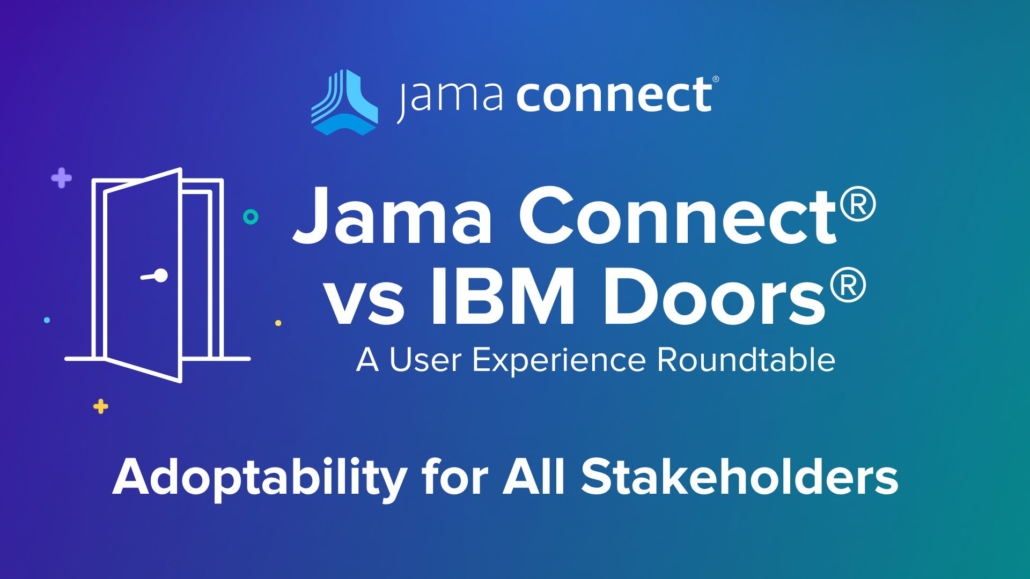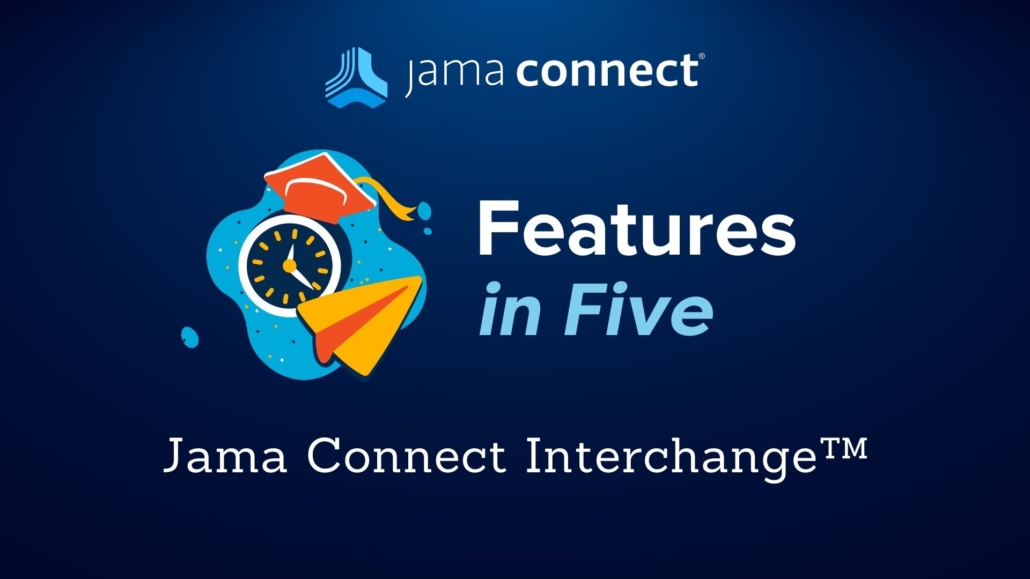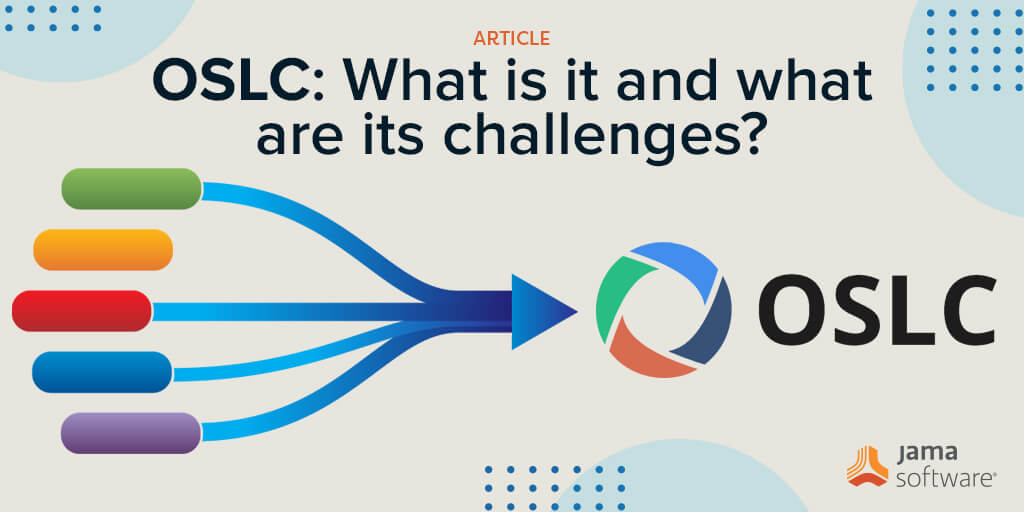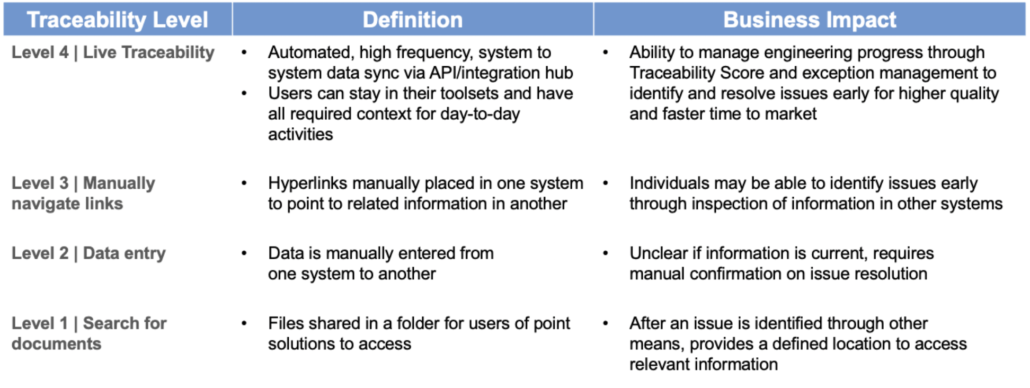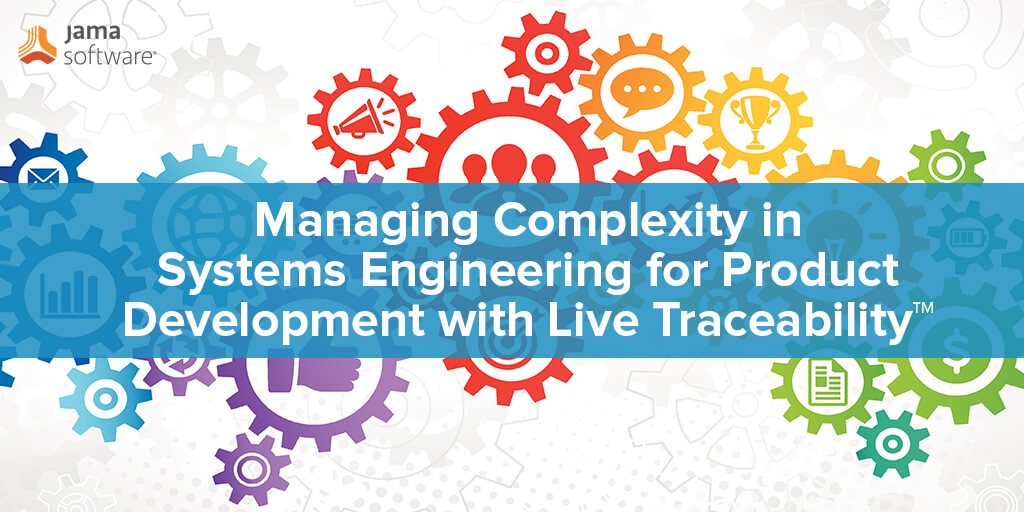A User Experience Roundtable Chat About Jama Connect® vs. DOORS®: Adoptability for All Stakeholders
Increasing industry challenges and complexities are pushing innovative organizations to consider modernizing the tool(s) they use for requirements management (RM). In this blog series, A User Experience Roundtable Chat About Jama Connect® vs. DOORS®, we’ll present several information-packed video blogs covering the challenges that teams face in their project management process.
In Episode 2 of our Roundtable Chat series, Cary Bryczek – Director of Solutions Architecture, Jama Software® and Susan Manupelli – Senior Solutions Architect, Jama Software® – walk us through the importance of adaptability, and ease of use, for all stakeholders in a requirements management tool.
To watch Episode 1 of this series, click HERE.
Watch this short video below to learn more and find the full video transcript below!
VIDEO TRANSCRIPT:
Cary Bryczek: Hi everybody. Welcome to part two of our vlog series. I hope you’re enjoying the series so far. My name is Cary Bryczek, and I’ll be representing Jama software today. In terms of experience, I’ve been using Jama for nine years, but have used DOORS and numerous other requirements tools for the past 20 years. I’m joined today by Susan.
Susan Manupelli: Hi there. My name is Susan Manupelli. I’m a solutions architect here at Jama Software. Prior to joining Jama, I was a test architect working on the engineering lifecycle management suite of products, particularly on Rational DOORS Next Generation and the Global Configuration Manager. So I’m happy to be here with you today to talk requirements management adoptability
Cary Bryczek: Thank you Susan. In this vlog, we’re going to be talking about the adoptability for all stakeholders. Adoptability, it might be the most important aspect for a requirements tool and sometimes it’s the most overlooked. Adoptability isn’t just about being able to get users to actually use the software, but it’s about how well it fits into the IT ecosystem. How hard or easy it is to maintain, or even whether or not the organization recognizes its benefits.
UI, Ease of Use, and Adoptability
Susan Manupelli: Right. Let’s talk… One of the first challenges in the adoption of DOORS Classic is that many dev teams are distributed globally. DOORS is a legacy client server application, which doesn’t scale well over the WAM, so DWA, DOORS Web Access, was released as the answer to that problem, but it lacks significant functionality only available in the desktop client.
Another challenge with DOORS Classic is that the UI look and feel is very dated. Modern engineering teams are energized by utilizing the very latest technologies for developing state-of-the-art products for the future, and then they’re asked to use a requirements tool that was designed some 30 years ago. So that just doesn’t fly very well.
Let’s talk a little bit about DOORS Next Generation. It was marketed as a new modern alternative to DOORS Classic. Unfortunately, it’s very hard to use. There are too many different options for use and a lack of direction on best practices. So we’ll go through some of these challenges in the vlog.
The first place where users struggle to adopt DOORS Next Generation is a very basic question; whether to use modules or not. DNG originally only allowed you to organize requirements in a tree view hierarchy of folders. And later, to accommodate users that were more familiar with DOORS Classic, modules were added to DNG. Modules provide a document-like view for requirements, but these same artifacts outside of the module view show up in alpha numeric order in the true view, it makes organization of artifacts outside of the module very confusing.
RELATED: Jama Connect® Solution for IBM® DOORS®
Cary Bryczek: Wow. Yeah, that does sound complicated to comprehend. Jama was developed as a web-based solution from scratch. We wanted to fulfill the lowest common denominator stakeholder so anybody could come in and use our software. Our UI is modern and intuitive. Let me show you what I mean.
This is what I mean about our UI. It’s very streamlined. There’s hardly any button clicks or menus to learn how to use. There’s four main menus. And then the rest of them are kind of like right click kinds of options. We have the dashboard built right in. Our views are super simple. The explorer tree matches exactly what you see in our list view. And our views are very simple to navigate. So if this is the list view, and I wanted to see a document or a reading kind of view, I can just toggle the buttons to show those different types of views.
Teaching someone how to use this is really super simple, and it doesn’t take that much time at all. In fact, analysts have even recognized Jama Software as being the easiest user tool in the marketplace. You can go out there and see something like from G2, which queries users without us even knowing about it to get their direct feedback on the tools.
Link Relationship Rules and Traceability
Susan Manupelli: Well thanks, Cary. That was great. Another area that’s confusing in DNG has to do with linking. Linking behavior is different between module artifacts and non-module artifacts. A lack of understanding leads to incorrect or incomplete traceability analysis. In DNG, if you link to artifacts that are outside of a module, the link is placed on the core artifact. If you link to artifacts within a module, the link only appears in that particular module. If you then print a traceability report, you’ll only see links made in the module context. So links to core artifacts won’t be displayed. So as a user, that behavior is very confusing.
Another gate to adoptability has to do with enforcing link relationships. Enforcing relationship rules in DNG it’s just hard to do. Either all links are allowed, which means that users can kind of willy-nilly apply link rules that don’t make sense really for relationship, or allowed link rules are specified in a list form for a given component, and then they must be recreated across all components in the project. There’s also no visual representation of link rules in DNG, and there’s no notion of enforcement of required link rules, so compliance is hard to maintain.
Cary Bryczek: Gosh, just listening to that sounds really confusing to me, and I’ve even used DOORS. In Jama, linking is just straightforward. If an item is linked to another item, that link relationship will be visible wherever you are in the UI. We also have the capability to see what our relationship schema looks like and enforce a consistent way to apply traceability. Let me show you what I mean.
There’s a couple of different ways to look at the traceability. I can see that traceability right away. So I know that this standard aircraft platform requirement is traced to another object downstream. I can see the traceability numbers, so this one in this list view. I can see that this one requirement has five different traceability things. I can see it also in the trace view. We’ll tee up a live real-time version of what’s currently traceable out there. It’s very easy to see where there’s gaps in traceability because there’s just no information there.
We have our traceability rule set. Think of this picture as being the schema for what types of objects are allowed to be traced to one another. So I might have four levels of requirements traceability. I might have test cases in there. And so this set of rules would enforce the users to create consistent traces. And then I can follow those rules down in the live trace view as well. So if I’m following this aircraft level requirement, I can see the system requirements, and any kind of lower level objects, whether those are high level software requirements. Here I see some verification tests and agency test runs. Traceability is really made to be super intuitive, real-time, live, to allow anybody to understand and analyze the current situation.
RELATED: G2 Recognizes Jama Connect as the Only Leader in Requirements Management
Administration and Maintenance
Susan Manupelli: Another common issue is that DOORS Next is hard to administer and maintain. Upgrades are often a challenge. As major architectural changes have occurred in recent releases of the DNG, the time and effort and ultimately the cost to upgrade has been daunting.
Another area of maintenance in DNG has to do with the type system. The type system, that’s the part of DNG that keeps track of your artifact types, your attributes and your values and their relationships. And that needs to be consistent from project to project for cross component and cross project reporting. And there’s no global way to keep these items in sync from project to project or component to component.
Cary Bryczek: Cool. That’s really different than the experience here at Jama. Our host of solutions get updates just about every 60 days. Middleware and security updates are handled as necessary. And sometimes the middlewares might take six months to a year or so. Very stable releases and changes to the ecosystem. We have self-hosted solutions and even customers that have air gap, we can satisfy those sort of ecosystem environments. Very easy to set up and deploy.
Now, it was interesting that you talked about, Susan, though the type rules. In Jama, we’re a little bit different for item types and attributes. We define those globally. Here’s an example.
Our type rules are defined globally, like I said. Here’s an example of schema for the types that are relevant to this particular achiever one project. When we define them globally, it’s all point and click kinds of experience of dealing with that. These attributes are now consistent from project to project to project. And that way you can have really easy reuse scenarios. If you’re doing complex scenarios like product line engineering or if you have complex libraries of data that you use from one project to the next, having that consistent type definition really makes it easier for you to do analysis, leverage reuse, have shorter project startup times.
RELATED: Why Investing in Requirements Management During an Economic Downturn Makes Good Business Sense
Running and Exporting Reports
Susan Manupelli: Yeah, sure. I can definitely see that. One other area that I wanted to talk about has to do with reporting. For all the effort that’s put into DNG to maintain the projects, to build up the requirement specs, the reporting needed to meet certifications is hard or sometimes impossible to create. Mistakes or inconsistencies in the type system that we just talked about, those often manifest as issues once you try to do some traceability reporting. Keeping data consistent between DNG in the reporting data stores has proven to be a challenge, so we’re talking about the data warehouse and LQE. And basically robust reporting out of DNG requires the use of additional IBM tooling, either Jazz Reporting Service, or RPE, the Rational Publishing Engine, and those products are outside of DNG.
Cary Bryczek: That sounds complicated. Again, one of the great things that we have at Jama is our reporting engine is built right into Jama itself. And Jama is a single application, so there’s no deploying 11 different servers of applications that are sort of cobbled together through an integration under the covers. Jama is just a single application. And exporting is super easy. Let me show you what I mean.
We have lots of built in reports. Lots of different kinds of reports that you can add in. We have the capability to export directly to Excel, Word, right there. All a user has to do is configure the view that they’re looking at, whether that’s the reading view or the list view that’s customized to match what they need to have. And then they can have the built in export templates that are just creatable via Microsoft Word templates, so there’s no custom coding in most cases that a user has to do to run these kinds of reports. Doesn’t that sound much easier, Susan?
Susan Manupelli: It sure does.
Cary Bryczek: That brings us to the end of this particular vlog. I hope you all have enjoyed it. Please, I hope you also take some time out to look at some of the other vlogs in this series. Thank you so much, Susan, for your perspective on DOORS and DNG as well.
Susan Manupelli: Thank you Cary. Happy to be here.
Thank you for watching our Episode 2, Jama Connect vs. DOORS: Adoptability for All Stakeholders. To watch Episode 1 of this video series, click HERE.
To learn more about available features in Jama Connect, visit: Empower Your Team and Improve Your Requirements Management Process
We hope you’ll join us for future Jama Connect Jama Connect vs. DOORS topics, including: Adoptability for All Stakeholders; Filters, Search and Analysis; Review and Collaboration; Document Generation; Migration & Data Mapping; Industry Templates; Reuse and Variant Management; Requirements-Driven Testing; Total Cost of Ownership; and Why Did We Move to Jama Connect? A Customer’s Story.
